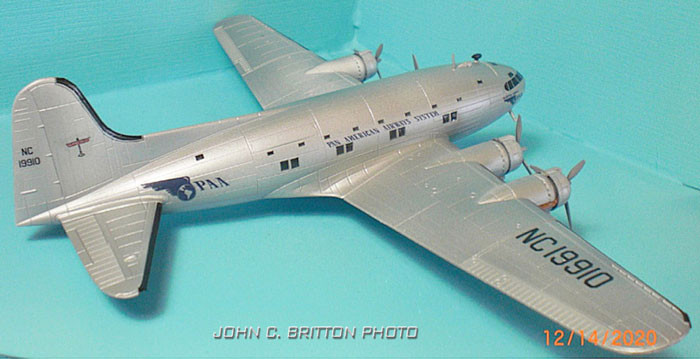Britton's Model Universe
A Life Commemorated - in Detail
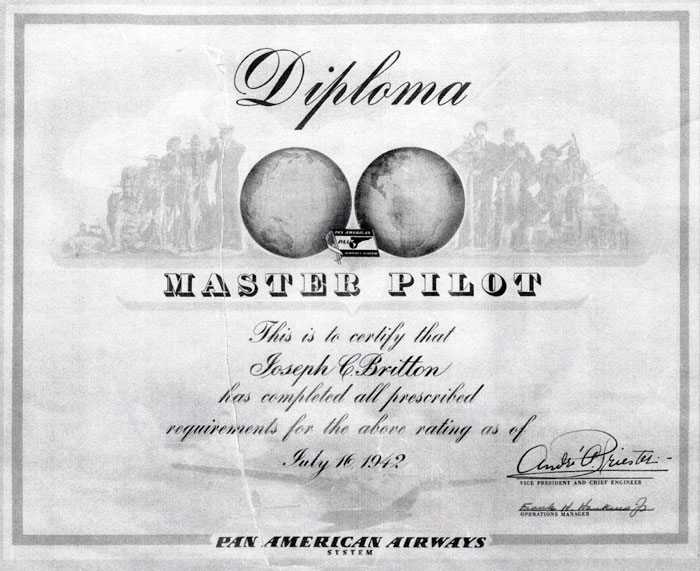
Master Pilot Certificate Britton, Joe Britton, 1942
Recently John C. Britton and his sister Jean C. Britton Glenn, the children of Pan American pilot Joe Britton wrote a wonderful biography of their late father, filled with photos and a recap of Joe's work with Pan Am. The details they shared are compelling.
Joe Britton had a remarkable and noteworthy career that spanned almost all of Pan Am’s pioneering over routes far and wide for almost two decades, through peace and war and back again. He passed away at a time when his children were still young, and could have kept flying into the Jet Age if fate hadn’t suddenly intervened. He left behind his log books, some photos, and a legacy.
That history impelled his son John to embark on a remarkable project as a way of remembering and honoring his father, by recreating in model form as many of the numerous aircraft Joe flew as possible. John meticulously provides every model he creates with a registration number of an aircraft his dad actually flew.
A Tribute in Photos:
View John’s models closeup in this slideshow. John shared that he still has a few other aircraft to add to his model fleet!
Sikorsky S-38 Amphibion / Sikorsky S-40 flying boat, November 13, 1938 / Consolidated Commodore flying boat, October 16, 1936 / Lockheed Constellation L-049, February 27, 1946 / Lockheed Constellation L-749, October 10, 1947 / Army C-87 (B-24 Freighter), November 15, 1943
John C. Britton's Model Universe
John C. Britton's Model Universe
A BRIEF BIOGRAPHY of JOE C. BRITTON, 1907-1958*
© John C. Britton and Jean C. Britton Glenn
Joe C. Britton, our father, was born in the Enid, Oklahoma area, on March 19, 1907. He grew up in Enid, attending Phillips University. He was fortunate enough to be in the forefront of the early development of commercial flying, the development of navigation and communication practices, and the evolution of Pan American aircraft, from the single-engined Fairchilds to the Boeing Stratocruiser. This was the period of “the Romance of Flying”, when every flight was an adventure. I feel sure he would have made the change-over to the jets, in time.
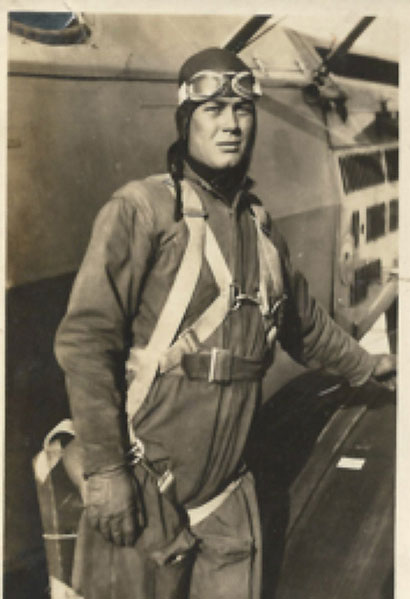
Joe Britton in the US Army Air Corps
Daddy attended Air Corps Primary Flying School at March Field, Riverside, CA, graduating on June 21, 1930, with subsequent training at Kelly Field, TX, Ft. Sill, OK, and Mather Field, CA. According to his military flight logs, he was on active duty until October 1931, when he was mustered out of the service due to the Depression.
His civilian log shows a few flights in the Enid area in 1931 and 1932. There was another stint of military training in the summer of 1935. He returned to teaching at that time, per an interview with him published in the Enid, OK, Morning News, November 9, 1952.
We do not know what drew our father to Pan American Airways in lieu of any of the other start-up airlines of the time. He clearly was not in the first echelons of personnel who got their names in all the books, but joined shortly thereafter, as the airline expanded rapidly. I am sure his experiences mirrored those of many other aircrew personnel at the time.
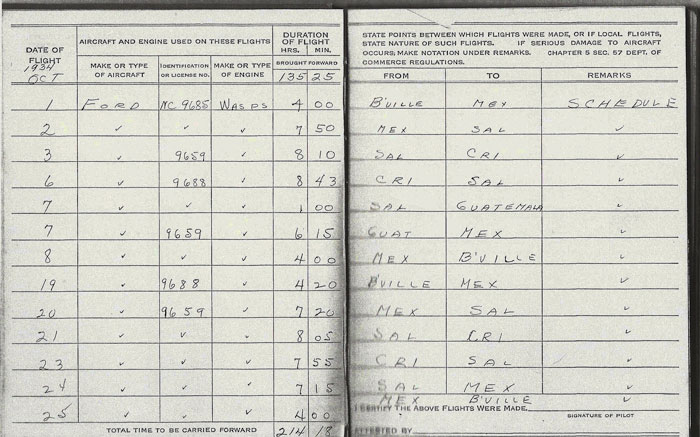
A page of Joe’s logbook, from October 1934
The first PAA log entry was a blind flying training flight in a Fairchild, on August 13, 1934, from Brownsville, TX. He graduated to Ford Tri-Motors on the route Brownsville to Cristobal, Canal Zone, and return. By November, 1934, he was flying Douglas DC-2s on that route and beyond, alternating with the Fords, and much training in Fairchilds.
As a sign of things to come, our father’s flights in a Consolidated Commodore flying boat began in Miami on October 16, 1936, with the first flight in the Sikorsky S-42, to Barranquilla, Colombia, on October 31, 1936.
He transferred to California and began regular service as Junior Flight Officer with the Martin M-130s on December 14, 1936. We have his certificates (Domain of Phoebus Apollo) for crossing the International dateline for the first time on the Philippine Clipper in December 17/18, 1936. This service continued through March, 1938, with additional ratings to First Officer, Navigator, and co-pilot training.
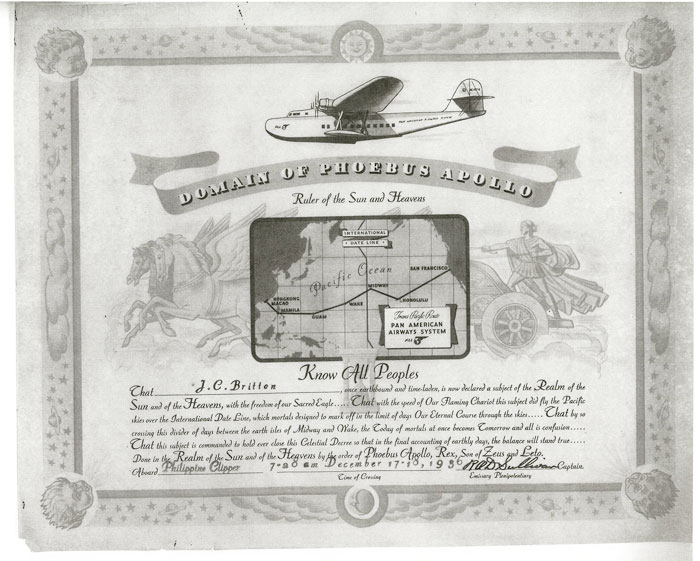
Capt. ROD Sullivan signed Joe’s Phoebus Apollo certificate on December 17th, 1936 – an auspicious date for an aviator, being the 33rd anniversary of the Wright Brothers’ flight at Kitty Hawk!
In May, 1938, he transferred back to Miami for training in the smaller twin-engine Sikorskys (S-38, S-43), beginning Caribbean service in July of that year. Additional flights were made on the S-42s and Commodores, and in December 1938, the older Sikorsky S-40s.
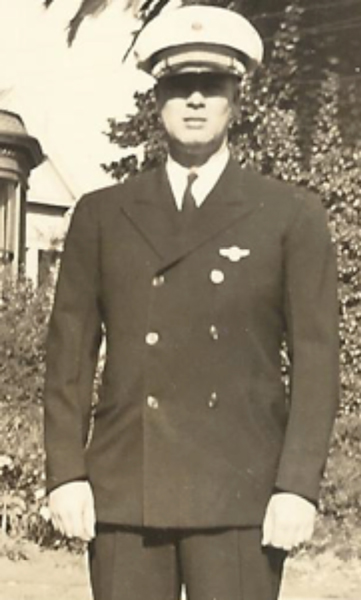
Joe Britton in his Pan Am Uniform, 1937
In July, 1939, he was moved back to Brownsville, returning to the Mexico-Central America routes on DC-2s, DC-3s and Fords. At one point on this run, he was “mentioned in dispatches” by Ernie Pyle, as reported in the St Petersburg Fla, Times, Feb 5, 1940.
In the article, Ernie wrote in part:
“When we piled out at the airport, we saw a short, young man In a uniform ccmlng to meet us, and we recognised him. I think maybe that is the greatest fun In all our traveling — running onto people you've met before. This young man was Joe Escalante, a flying steward of Pan American. We had flown with him more than a year ago along the north coast of Colombia We remembered each other well.
While we were checking our tickets, here came another man In uniform - a tall, handsome man, and we knew him too. We had flown two whole days with him on the Clippers, from Rio clear up to Para, at the mouth of the Amazon.
He was co-plloting when we rode with him last, but today he was captain of the ship, Capt. Joe Britton. I don't know what could make a flight over faraway foreign countries happier than to have a captain and a steward that you know.”
We have a copy of Daddy’s Master Pilot Diploma, and his wings, dated July 16, 1942. He also stated in the Enid newspaper interview that he flew Clark Gable from Mexico to Panama. This service continued through the outbreak of World War II until March, 1943. In April, 1943, he transitioned to the Boeing 307 Stratoliner, staying in Latin America, and serving the war effort.
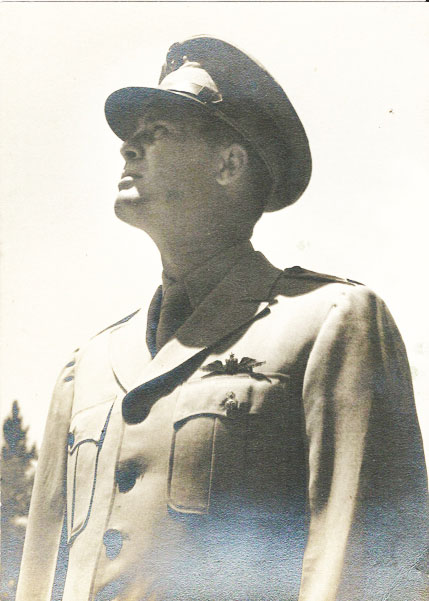
Joe served in Pan Am’s Africa-Orient Division
PAA Africa-Orient Division was begun on November 10, 1942. With Pan Am’s war effort gearing up, he returned to Miami in October, 1943, and married our mother, Clara Koehler Steele in November. He then transitioned to C-54s and C-87s for the transatlantic routes with the Africa Orient division. His first Ocean Command was on board a C-87 from Natal, Brazil, to Accra, Ghana on December 9, 1943.
Per the logs, Daddy flew this area (Miami to points in Africa, as far as Karachi, India) from November 25, 1943, through the end of May, 1944, flying supplies over, and wounded back. A log entry for December 11, 1944, notes the birth of my sister Jean. The remainder of the war saw trans-Atlantic and other flights, including a civilian survey flight from La Guardia in New York to Leopoldville, Belgian Congo, in October, 1945. We have a Pan American photo noting “In 9 days, flew 114 hours, 22,800 miles”.
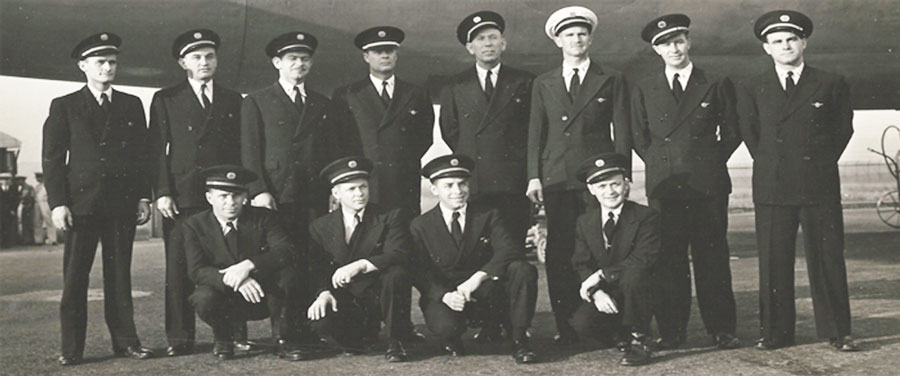
Joe, standing, fourth from left, before departing for the survey to Africa
In November, 1945, he began co-pilot training on civilian DC-4s, and started post-war civilian transatlantic service in December.
February, 1946, he began the transition to the Lockheed L-049 Constellation, which he flew in alternation with the DC-4s.
Here is a photo of him in the May 16, 1946, edition of The Clipper, in the cockpit of a DC-4.
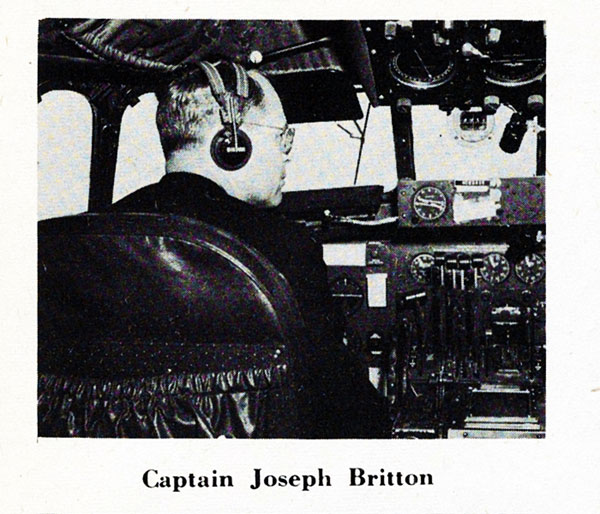
Capt. Britton’s passengers on the flight were famous English actors Vivien Leigh and Laurence Olivier. The plane was dubbed the “Old Vic Clipper.” (Courtesy Univ. of Miami Special Collections.)
The first non-stop flight New York to London was noted in the log for May 12-13, 1947. He flew a charter flight from Damascus to Dhahran, Saudi Arabia, in October, 1947.
Transition to the L-749 Constellation began in October, 1947. The transatlantic runs continued through June, 1948, with continuation trips on to the Middle East and India in both Constellation variants.
A transfer to San Francisco in July, 1948, heralded his return to the Pacific routes in September of that year in DC-4s, flying the inaugural flight from Honolulu to Portland, OR, on November 28, 1948, and continuing through February, 1949. My birth log entry came that month.
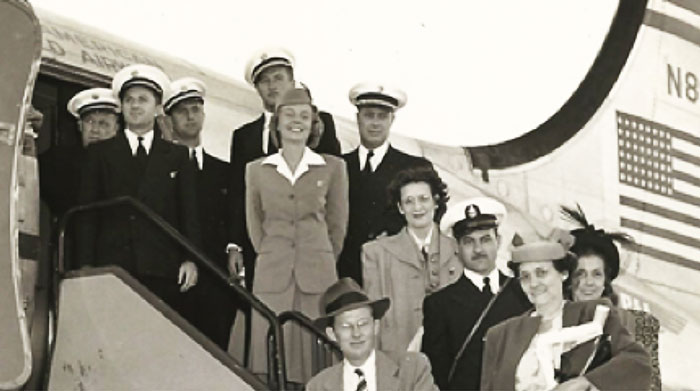
Crew and passengers of the inaugural flight of PAA, Honolulu to Seattle, arrived November 2, 1948. Joe Britton behind stewardess, to her left.
In March and April, 1949, Daddy began training in the new larger Boeing 377, with the first flight from San Francisco on April 29. First solo revenue flight was between San Francisco and Los Angeles on May 19, 1949. The log is littered with notes of mechanical troubles. His flights from the west coast to Honolulu began in June of that year, and in February, 1950, flying the Pacific check trips using the old China Clipper route.
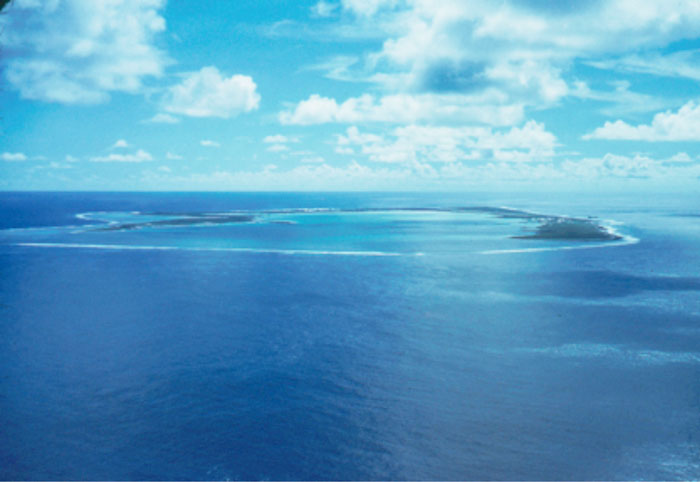
Wake Island,1951, from 5 miles out
Passenger service began in March, 1950. Destinations included Auckland, Tokyo and Manila. My mother said he loved this plane. We have a copy of the August 11,1949 The Clipper, listing Daddy at 15 years of service in Flight Operations, San Francisco.
All was not dreary work. There was time for recreation in route, exploring the debris of war. Here, personnel examine the wreck of a Japanese seaplane, also on Wake Island.
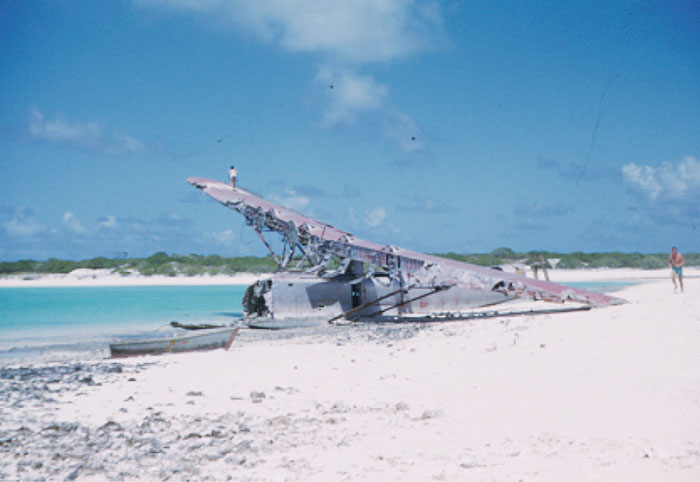
Japanese Kawanishi flying boat wreck on Wake
Routine flights continued until May 4, 1952, and ended with the log entry “became ill in HNL”, with a carotid artery thrombosis, a stroke-type event, which effectively ended his flying career. Remaining B-377 flights were all in the San Francisco area, trying to get back into the game, ending in May, 1953. He had amassed a total of 13,946.31 hours. We eventually relocated to Houston, where our father returned to teaching.
He kept up contacts with PAA and personnel. He died of a heart attack on November 1, 1958, while in Herman Hospital in Houston during a recertification physical.

